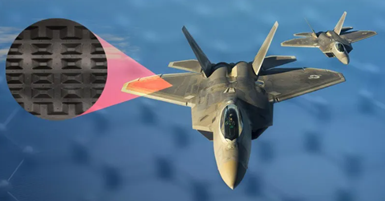UD researchers advance TuFF composite's viability for aerospace
The University of Delaware’s research team continues to mature the short fiber composite’s cost competitiveness with metal through sensor embedding, virtual modeling and TuFF thermoset manufacture.
Share

Photo Credit: University of Delaware
TuFF — tailored universal feedstock for forming — is a strong, highly aligned, short-fiber composite material that can be made from many fiber and resin combinations. Created at the University of Delaware’s Center for Composite Materials (UD-CCM, Newark, U.S.), it can be stamped into complex shapes, just like sheet metal, and features high-performance and stretchability up to 40%.
Since its introduction, CCM researchers have explored applications for TuFF, from materials for repairing U.S. pipelines to uses in flying taxis of the future (see “…TuFF composite material shows high potential for UAM” and “UD’s Center for Composite Materials hosts NASA University Leadership Initiative”). Now, armed with $13.5 million in funding from the U.S. Air Force, UD mechanical engineers and co-principal investigators Suresh Advani and Erik Thostenson, along with industry collaborators Composites Automation (Cape Coral, Fla., U.S.) and Maher and Associates (Baltimore, Md., U.S.) are working on ways to improve manufacturing methods for TuFF.
“I am excited at the opportunity to mature the TuFF prepregging process and demonstrate high-throughput composite thermoforming for Air Force-relevant components,” David Simone of the U.S. Air Force says.
The ultimate goal is to enable composites to be become cost-competitive with aluminum for creating small parts found in air vehicles. Advani, George W. Laird professor of mechanical engineering, explains that when it comes to making aircraft materials more cost-efficient, reducing a material’s weight even a mere kilogram, just 2.2. pounds, will reduce fuel consumption and emissions and can result in thousands of dollars in savings over time.
“In general, the aerospace industry wants to reduce weight and replace metals,” Advani says. “TuFF is a good option because the material can achieve properties equivalent to the best continuous fiber composites used in aerospace applications.”
Advancing TuFF thermosets
Until now, most of the work around TuFF has focused on thermoplastic composite materials that melt when heated, becoming soft and pliable, which is useful for forming. By contrast, TuFF thermosets have a higher temperature threshold, making them useful for aerospace applications. But TuFF thermosets have manufacturing challenges, too, according to researchers, including the long manufacturing times necessary to make a part.
In this new project, Thostenson and Advani will work on ways to improve the viability of thermoset TuFF composites. To start, the researchers will characterize the starting materials’ mechanical properties to understand how to make TuFF thermosets reliably and consistently. The research team will explore whether they can make the material in a new way, using thin resin films and liquid resins. They will also test the limits of how the material forms and behaves under pressure and temperature.
“I am hoping this work will allow us finally to make composites cost competitive with the metal industry.”
“How does it stretch during forming in a mold? What shapes can we make? When does it tear or thin or develop voids that can compromise material integrity?” Advani asks. He believes that having a database for such properties and behaviors will be useful in understanding TuFF material capabilities and limits, and to inform efforts to model and design parts with TuFF.
Thostenson, professor of mechanical engineering, and an expert in structural health monitoring (SHM) of materials, is advancing ways to embed sensor technology into TuFF thermosets so as to better gauge — and improve — the material’s damage tolerance. A single layer of TuFF material is approximately 100 microns thick, about the diameter of the average human hair. The carbon-nanotube sensors Thostenson plans to integrate into the material are smaller still — one billionth the width of a human hair.
“This would allow us to do health monitoring for the materials and parts during service life, but you could also imagine using sensor technology to detect a defect during manufacturing,” Thostenson says.
The research team also plans to develop a virtual modeling system to refine the material-forming process through computer simulation instead of by trial and error. In this way, the team will better understand each step in the material-forming process, enhancing the team’s ability to make TuFF materials consistently and reliably — a must for aerospace applications.
“I am hoping this work will allow us finally to make composites cost competitive with the metal industry,” Advani adds.
In addition to Thostenson and Advani, the team includes, from CCM, Jack Gillespie, Dirk Heider, Shridhar Yarlagadda, Thomas Cender, John Tierney and Pavel Simacek, along with four to five graduate students.
Related Content
Plant tour: Joby Aviation, Marina, Calif., U.S.
As the advanced air mobility market begins to take shape, market leader Joby Aviation works to industrialize composites manufacturing for its first-generation, composites-intensive, all-electric air taxi.
Read MoreA new era for ceramic matrix composites
CMC is expanding, with new fiber production in Europe, faster processes and higher temperature materials enabling applications for industry, hypersonics and New Space.
Read MoreCryo-compressed hydrogen, the best solution for storage and refueling stations?
Cryomotive’s CRYOGAS solution claims the highest storage density, lowest refueling cost and widest operating range without H2 losses while using one-fifth the carbon fiber required in compressed gas tanks.
Read MorePlant tour: Albany Engineered Composites, Rochester, N.H., U.S.
Efficient, high-quality, well-controlled composites manufacturing at volume is the mantra for this 3D weaving specialist.
Read MoreRead Next
VIDEO: High-volume processing for fiberglass components
Cannon Ergos, a company specializing in high-ton presses and equipment for composites fabrication and plastics processing, displayed automotive and industrial components at CAMX 2024.
Read MoreDeveloping bonded composite repair for ships, offshore units
Bureau Veritas and industry partners issue guidelines and pave the way for certification via StrengthBond Offshore project.
Read MoreAll-recycled, needle-punched nonwoven CFRP slashes carbon footprint of Formula 2 seat
Dallara and Tenowo collaborate to produce a race-ready Formula 2 seat using recycled carbon fiber, reducing CO2 emissions by 97.5% compared to virgin materials.
Read More









